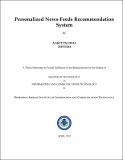Personalized News-Feeds Recommendation System
Abstract
"The idea of personalization of recommendations is a very important factor - both for users as well as organizations. Users want their experience on a website to be as comfortable as possible, and the organizations want to lure more and more users on their platform. Whether it is shopping on-line or gathering information from across the world, Recommendation engines are changing the way people communicate with these on-line systems, and helping them to make their experiences better.
Personalizing News-feeds recommendations is one such system, that helps users on a platform to stay updated with news from all over the globe. Every user has his/her own preferences and interests, which he/she seems to prefer over others. Our aim here, was to design one such system that is able to show the users what they are interested in and not bother them with unwanted material.
Their have been many past researches on this topic, each has handled the problem in their own unique way. The major idea behind the systems, however, remains more or less the same, and that is to capture user’s interests. Once the system is able to do that precisely, the recommendation part becomes easy. Different authors use different tools and technologies to do this. Some use Topic Modelling, some others use Deep Learning and some people who use different variations of Hybrid recommendation systems.
In this work, I have used Topic Modelling and the idea of penalizing these topics, based on what user prefers to see and what he does not. Our whole program runs as a layer above the model generated using Latent Dirichlet Allocation."
Collections
- M Tech Dissertations [923]

